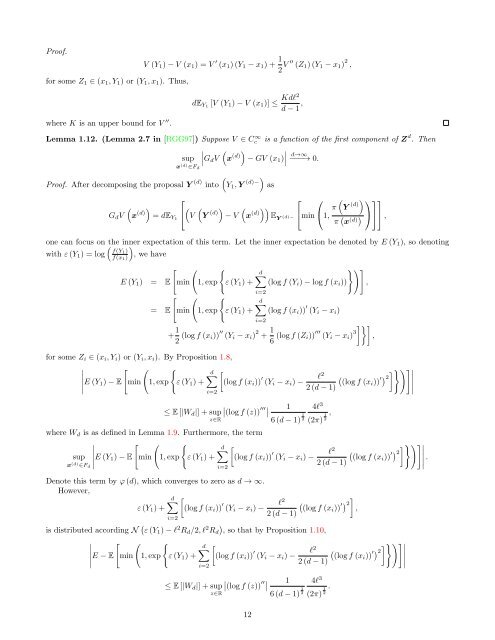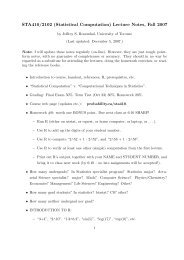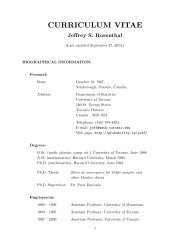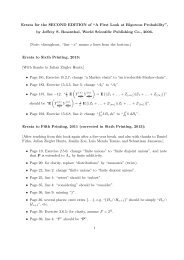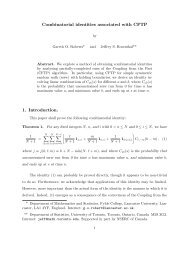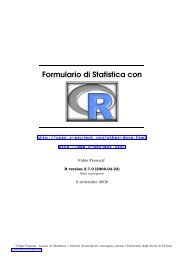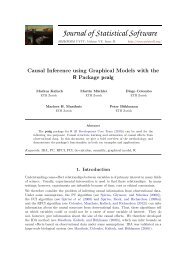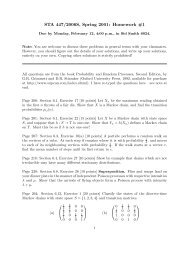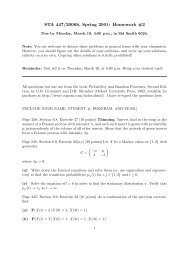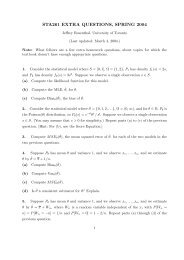final report - probability.ca
final report - probability.ca
final report - probability.ca
Create successful ePaper yourself
Turn your PDF publications into a flip-book with our unique Google optimized e-Paper software.
Proof.<br />
V (Y 1 ) − V (x 1 ) = V ′ (x 1 ) (Y 1 − x 1 ) + 1 2 V ′′ (Z 1 ) (Y 1 − x 1 ) 2 ,<br />
for some Z 1 ∈ (x 1 , Y 1 ) or (Y 1 , x 1 ). Thus,<br />
where K is an upper bound for V ′′ .<br />
dE Y1 [V (Y 1 ) − V (x 1 )] ≤ Kdl2<br />
d − 1 ,<br />
Lemma 1.12. (Lemma 2.7 in [RGG97]) Suppose V ∈ Cc<br />
∞ is a function of the first component of Z d . Then<br />
∣ ( ∣∣Gd<br />
sup V x (d)) − GV (x 1 ) ∣ −−−→ d→∞<br />
0.<br />
x (d) ∈F d<br />
Proof. After decomposing the proposal Y (d) into<br />
(<br />
Y 1 , Y (d)−) as<br />
⎡<br />
(<br />
G d V x (d)) = dE Y1<br />
⎣ ( ⎡ ⎛<br />
(<br />
V Y (d)) (<br />
− V x (d))) E Y (d)−<br />
⎣min ⎝1,<br />
(<br />
f(Y1)<br />
f(x 1)<br />
π<br />
(Y (d)) ⎞<br />
π ( x (d)) ⎠<br />
one <strong>ca</strong>n focus on the inner ) expectation of this term. Let the inner expectation be denoted by E (Y 1 ), so denoting<br />
with ε (Y 1 ) = log , we have<br />
E (Y 1 ) = E<br />
= E<br />
[<br />
[<br />
min<br />
min<br />
(<br />
(<br />
1, exp<br />
1, exp<br />
for some Z i ∈ (x i , Y i ) or (Y i , x i ). By Proposition 1.8,<br />
[ ( {<br />
d∑<br />
∣ E (Y 1) − E min 1, exp ε (Y 1 ) +<br />
{<br />
{<br />
ε (Y 1 ) +<br />
ε (Y 1 ) +<br />
})]<br />
d∑<br />
(log f (Y i ) − log f (x i )) ,<br />
i=2<br />
d∑<br />
(log f (x i )) ′ (Y i − x i )<br />
i=2<br />
+ 1 2 (log f (x i)) ′′ (Y i − x i ) 2 + 1 6 (log f (Z i)) ′′′ (Y i − x i ) 3 ]}]<br />
,<br />
i=2<br />
[<br />
(log f (x i )) ′ (Y i − x i ) −<br />
≤ E [|W d |] + sup ∣ ′′′ ∣ (log f (z)) z∈R<br />
where W d is as defined in Lemma 1.9. Furthermore, the term<br />
∣ [ ( {<br />
∣∣∣∣ d∑<br />
sup E (Y 1 ) − E min 1, exp ε (Y 1 ) +<br />
x (d) ∈F d<br />
i=2<br />
1 4l 3<br />
,<br />
6 (d − 1) 1 2<br />
(2π) 1 2<br />
[<br />
(log f (x i )) ′ (Y i − x i ) −<br />
⎤⎤<br />
⎦⎦ ,<br />
l 2 (<br />
(log f (xi )) ′) ] })]∣ ∣<br />
2 ∣∣∣<br />
2 (d − 1)<br />
Denote this term by ϕ (d), which converges to zero as d → ∞.<br />
However,<br />
d∑<br />
[<br />
ε (Y 1 ) + (log f (x i )) ′ l 2 (<br />
(Y i − x i ) − (log f (xi )) ′) ]<br />
2<br />
,<br />
2 (d − 1)<br />
i=2<br />
l 2 (<br />
(log f (xi )) ′) ] })]∣ ∣<br />
2 ∣∣∣<br />
.<br />
2 (d − 1)<br />
is distributed according N ( )<br />
ε (Y 1 ) − l 2 R d /2, l 2 R d , so that by Proposition 1.10,<br />
[ ( {<br />
d∑<br />
[<br />
∣ E − E min 1, exp ε (Y 1 ) + (log f (x i )) ′ l 2 (<br />
(Y i − x i ) − (log f (xi )) ′) ] })]∣ ∣<br />
2 ∣∣∣<br />
2 (d − 1)<br />
i=2<br />
∣<br />
≤ E [|W d |] + sup ∣(log f (z)) ′′∣ ∣<br />
z∈R<br />
12<br />
1 4l 3<br />
.<br />
6 (d − 1) 1 2<br />
(2π) 1 2


